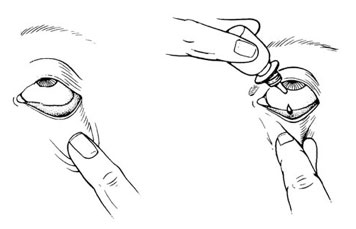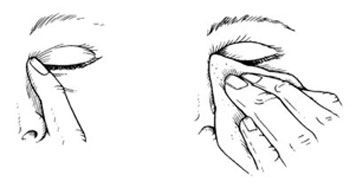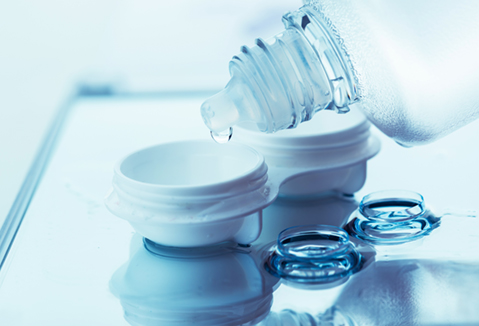Suggestions
How To Instill Eye Drops
Infections, inflammation, glaucoma, and many other eye disorders often are treated with medicated eyedrops.
It is important to remember that all medicines can have side effects. Surprisingly, even the small amount of medication in an eyedrop can create significant side effects in other parts of the body. There are ways to decrease the absorption rate of the eyedrop into the system and to increase the time the eyedrop is on the eye, making the medicine safer and more effective.

Instilling eyedrops may seem difficult at first but becomes easier with practice. To place an eyedrop in your eye, first tilt back your head. Then create a “pocket” in front of the eye by pulling down on the lower with an index finger or by gently pinching the lower lid outward with the thumb and index finger. Let the drop fall into the pocket without touching the dropper tip to your eye, eyelid, or fingers, so as to prevent contaminating the bottle.
Immediately after instilling the drop, press on the inside corner of the eyelids next to the bridge of your nose for two to three minutes with your thumb and forefinger. This prevents most of the drop from traveling down the tear duct to the back of the throat, where it then is absorbed by the rest of the body. Keep your eyes closed for three to five minutes after instilling eyedrops.

Before opening your eyes, dab unabsorbed drops and tears from the closed lids with a tissue.
If you are taking two different types of eyedrops, wait at least five minutes before instilling the second drop. Because the volume of a single drop exceeds the capacity of the surface of the eye, it serves no purpose to use two drops at the same time.
For more information on Macular Degeneration (ARMD) please click on the link below:
Suggestions for healthy contact lens wear:

- Always wash your hands before handling your contact lenses
- Always clean your lenses after taking them out and before putting them in the storage case
- Keep your storage case clean!!! Rinse with water and let it dry out bottom-up after every use and wash your case with soapy water once a week
- Replace your storage case every 3 months
- Do not switch solutions. Your doctor will recommend a specific solution for your type of lens. Switching solutions may lead to allergies, unclean contact lenses or eye infections (see suggestions on solutions below)
- Follow the directions for the solution recommended by your doctor
- Replace your lenses as recommended by your doctor. This decreases the risk of possible complications from contact lens wear
- The risk of infection with extended wear (sleeping overnight in contact lenses) is 15x higher than when patients do not sleep in contact lenses
- Do not sleep in your contact lenses unless your doctor has approved your lenses for overnight wear
- Always have a back-up pair of glasses for emergencies and times you cannot wear your contact lenses
- Sunglasses are recommended to protect your eyes from UV exposure
- Return for your doctor-recommended regular check-ups if you wear contact lenses
- If you experience redness, itching, sensitivity to light, blurry vision, pain or anything unusual when wearing your contact lenses, remove your lenses and contact your eye care provider.
Suggestions for contact lens solutions:

- Different solutions cannot always be used together and not all solutions are safe for use with all lenses. Use only recommended solutions with your contact lenses.
- Do not heat the wetting/soaking solution and lenses.
- Always use fresh un-expired lens care solution. Keep the container closed after using.
- Always follow directions in the package inserts of the contact lens solutions used.
- Use only a chemical lens care system. Use of a heat (thermal) lens care system can cause damage by warping the contact lenses.
- Sterile unpreserved solutions, when used, should be discarded after the time specified in the labeling directions.
- Do not use saliva or anything other than the recommended solutions for lubricating or wetting lenses.
- Always keep the lenses completely immersed in the recommended storage solution when the lenses are not being worn (stored).

